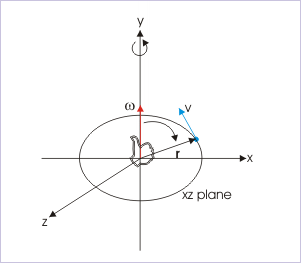| << Chapter < Page | Chapter >> Page > |
Vector cross product

We place our right hand such that the curl of fingers follows the direction of arc. The extended thumb, then, represents the direction of cross product ( v ), which is perpendicular (this fact lets us draw the exact direction) to each of the vectors and the plane containing two vectors ( ω and r ) whose products is being evaluated. In the case of circular motion, vectors ω and r are perpendicular to each other and vector v is perpendicular to the plane defined by vectors ω and r .
Vector cross product

Thus, we see that the interpretation of cross products completely defines the directions of quantities involved at the expense of developing skill to interpret vector product (we may require to do a bit of practice).
Also, we can evaluate magnitude (speed) as :
where θ is the angle between two vectors ω and r. In the case of circular motion, θ = 90°, Hence,
Thus, we have every detail of directional quantities involved in the equation by remembering vector form of equation.
In the case of the uniform circular motion, the speed (v) of the particle is constant (by definition). This implies that angular velocity (ω = v/r) in uniform circular motion is also constant.
Also, the time period of the uniform circular motion is :
The description of circular motion is described better in terms of angular quantity than its linear counter part.
The reasons are easy to understand. For example, consider the case of uniform circular motion. Here, the velocity of particle is changing - though the motion is “uniform”. The two concepts do not go together. The general connotation of the term “uniform” indicates “constant”, but the velocity is actually changing all the time.
When we describe the same uniform circular motion in terms of angular velocity, there is no contradiction. The velocity (i.e. angular velocity) is indeed constant. This is the first advantage of describing uniform circular motion in terms of angular velocity.
In other words, the vector manipulation or analysis of linear velocity along the circular path is complicated as its direction is specific to a particular point on the circular path and is basically multi-directional. On the other hand, direction of angular velocity is limited to be bi-directional at the most, along the fixed axis of rotation.
Linear and angular velocity

Second advantage is that angular velocity conveys the physical sense of the rotation of the particle as against linear velocity, which indicates translational motion. Alternatively, angular description emphasizes the distinction between two types of motion (translational and rotational).
Finally, angular quantities allow to write equations of motion as available for translational motion with constant acceleration. For illustration purpose, we can refer to equation of motion connecting initial and final angular velocities for a motion with constant angular acceleration “α” as :

Notification Switch
Would you like to follow the 'Physics for k-12' conversation and receive update notifications?